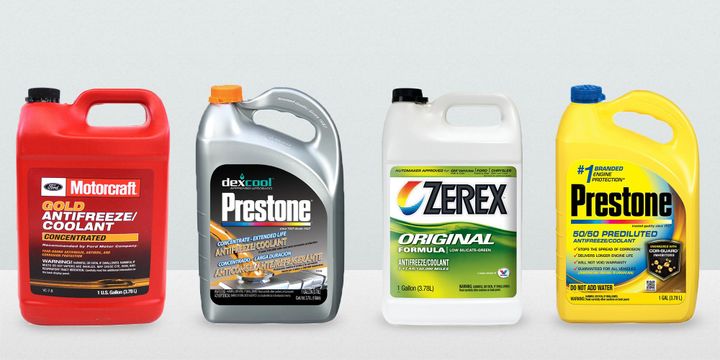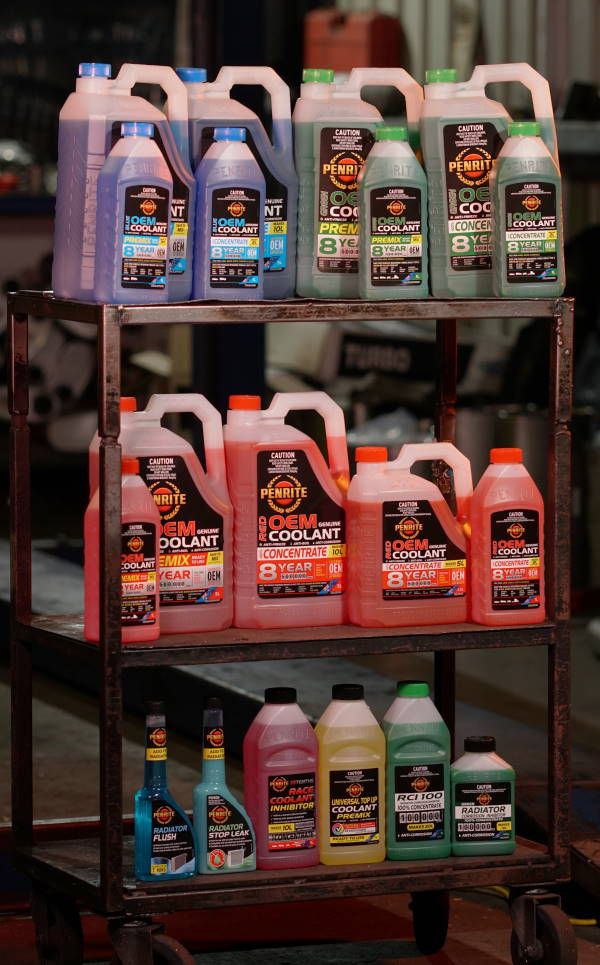


Coolants, also known as antifreeze, play a vital role in regulating engine temperature and preventing overheating or freezing in a vehicle's cooling system. This comprehensive guide explores the different types of coolants, their properties, and maintenance requirements, empowering vehicle owners to make informed decisions.

Engines generate immense heat during operation, and without an effective cooling system, they would quickly overheat and sustain severe damage. Coolants circulate through the engine, absorbing heat and transferring it to the radiator, where it dissipates into the surrounding air. Additionally, coolants raise the boiling point and lower the freezing point of the coolant mixture, ensuring optimal performance in extreme temperature conditions.
There are three main types of coolants used in modern vehicles, each with its unique characteristics and applications. The table below summarizes their key features:
| Coolant Type | Color | Chemistry | Service Life | Compatibility |
|---|---|---|---|---|
| Inorganic Additive Technology (IAT) | Green | Inorganic inhibitors (silicates, phosphates, nitrites) | 2 years or 24,000 miles | Older vehicles, compatible with conventional coolants |
| Organic Acid Technology (OAT) | Orange, red, yellow, purple | Organic acid inhibitors (sebacates, benzoates) | 5 years or 50,000 miles | Modern vehicles, especially GM, with aluminum components |
| Hybrid Organic Acid Technology (HOAT) | Various colors | Organic and inorganic inhibitors | 5 years or 50,000 miles | Wide range of cooling system materials |
Conventional coolants with inorganic corrosion inhibitors
Shorter service life, typically requiring replacement every 2 years or 24,000 miles
Compatible with older vehicles and cooling systems designed for traditional coolants
Mixing with other coolant types is not recommended
Advanced coolants with organic acid corrosion inhibitors
Longer service life, up to 5 years or 50,000 miles
Commonly used in General Motors vehicles and those with aluminum components
Available in various colors, including orange, red, yellow, and purple
Hybrid formulation combining organic and inorganic inhibitors
Similar service life to OAT coolants, around 5 years or 50,000 miles
Compatible with a wide range of cooling system materials
Designed for improved corrosion protection and extended service life
Coolants are engineered to perform several critical functions in a vehicle's cooling system. Understanding their properties and functions is essential for proper maintenance and troubleshooting.
Heat Transfer Efficiency: Coolants efficiently transfer heat from the engine to the radiator, ensuring effective temperature regulation.
Boiling and Freezing Point Protection: Coolants raise the boiling point and lower the freezing point of the coolant mixture, preventing overheating and freezing.
Corrosion Inhibition: Coolants contain corrosion inhibitors that form a protective layer on metal surfaces, preventing degradation and extending the cooling system's lifespan.
pH Level and Specific Gravity: These properties indicate the coolant's condition and effectiveness, with manufacturers providing recommended ranges.
Electrical Conductivity: Coolants have low electrical conductivity to prevent galvanic corrosion and minimize the risk of electrical shorts.
Toxicity and Environmental Impact: While essential for vehicle operation, coolants can be toxic and harmful to the environment if not handled and disposed of properly.
Selecting the correct coolant type and ensuring compatibility with your vehicle's cooling system is crucial for optimal performance and longevity. Always refer to your vehicle's owner's manual or consult with a professional to ensure you use the recommended coolant type.
Mixing different coolant types, such as IAT and OAT or HOAT, is generally not recommended as it can compromise the performance and protection offered by each coolant type. If mixing is unavoidable, follow the manufacturer's guidelines and flush the cooling system thoroughly to minimize potential issues.
Proper coolant maintenance is essential for ensuring the longevity and efficient operation of your vehicle's cooling system. Here are some key maintenance tasks:
Checking and Topping Up Coolant Levels: Regularly check and maintain the correct coolant level to prevent overheating and potential engine damage.
Coolant Flush and Replacement: Follow the manufacturer's recommended coolant flush and replacement intervals to maintain optimal cooling system performance.
Detecting and Repairing Coolant Leaks: Regularly inspect the cooling system for leaks and address them promptly to maintain proper coolant levels and prevent further issues.
Coolant System Pressure Testing: Regular pressure testing can help identify potential issues, such as leaks, faulty radiator caps, or other cooling system component failures.
Proper coolant disposal and environmental considerations are essential for minimizing the impact of coolants on the environment and human health.
Proper Disposal Methods: Coolants should never be poured down drains or onto the ground. Instead, dispose of them at designated recycling or hazardous waste facilities.
Environmental Impact: Improper coolant disposal can lead to water pollution, soil contamination, and harm to aquatic life and ecosystems.
Coolant Recycling Programs: Many automotive retailers, service centers, and municipalities offer coolant recycling programs to promote proper disposal and minimize environmental impact.
Despite proper maintenance, coolant-related issues can still arise. Common problems and their potential causes include:
Overheating and Coolant Loss: Caused by coolant leaks, low coolant levels, faulty thermostat or water pump, or cooling system blockages.
Coolant Contamination and Degradation: Can occur due to mixing incompatible coolant types, exposure to extreme temperatures, or the introduction of contaminants.
Cooling System Component Failures: Components like the water pump, thermostat, radiator, or hoses can fail over time or due to coolant-related issues.
Regular inspections, timely replacement of worn or faulty components, and addressing the root cause are essential to prevent further damage and ensure proper cooling system operation.
As automotive technology continues to evolve, coolant formulations and cooling system designs are also advancing to meet new challenges and environmental concerns.
Improved Coolant Formulations: Manufacturers are working on improving coolant formulations to offer longer service life, better heat transfer efficiency, and enhanced compatibility with modern cooling system materials.
Environmentally Friendly Coolant Alternatives: There is a growing demand for more environmentally friendly coolant alternatives, such as bio-based coolants derived from renewable sources and coolants with lower toxicity and improved biodegradability.
Advancements in Cooling System Design: Cooling system designs are evolving to accommodate new engine technologies, such as downsized turbocharged engines and hybrid/electric powertrains, which may require specialized coolant formulations or cooling system configurations.
Maintaining the proper coolant type and level is crucial for ensuring the longevity and efficient operation of your vehicle's cooling system. By understanding the different coolant types, their properties, and maintenance requirements, you can make informed decisions to protect your engine and minimize environmental impact. Regular coolant maintenance, timely replacement, and proper disposal practices will help you avoid costly repairs and ensure your vehicle's cooling system operates at its best.
Engine coolant regulates the engine's temperature by absorbing heat and transferring it to the radiator. It also raises the boiling point and lowers the freezing point of the coolant mixture.
Always refer to your vehicle's owner's manual or consult with a professional mechanic to ensure you use the recommended coolant type for your specific make and model.
Mixing different coolant types, such as IAT and OAT or HOAT, is generally not recommended as it can compromise the performance and protection offered by each coolant type.
It is recommended to check your coolant level twice a year or before the "Check Coolant" warning light illuminates on your dashboard.
Signs of a coolant leak include a sweet odor when driving, coolant puddles under the vehicle, and the need to frequently top up the coolant reservoir.
Used coolant should never be poured down drains or onto the ground. Instead, dispose of it at designated recycling or hazardous waste facilities.
If coolant is not changed regularly, it can become acidic, lose its rust-inhibiting properties, and cause corrosion in the cooling system, leading to potential engine overheating.
While it is possible to flush and refill your coolant yourself, it is recommended to have an experienced mechanic assist you, especially if it is your first time performing this task.
If your engine overheats, pull over to a safe location, turn off the engine, and allow it to cool down before checking the coolant level and seeking professional assistance.
Yes, there is a growing demand for more environmentally friendly coolant alternatives, such as bio-based coolants derived from renewable sources and coolants with lower toxicity and improved biodegradability.

Miguel started tinkering with car radios as a teenager, fascinated by the intricate dance of wires and circuits. This passion led him to pursue a career as an automotive electrician. For the past 10 years, Miguel has tackled everything from flickering headlights to mysterious electrical gremlins. He thrives on troubleshooting electrical problems and enjoys sharing his knowledge to empower car owners to understand their vehicles better.








